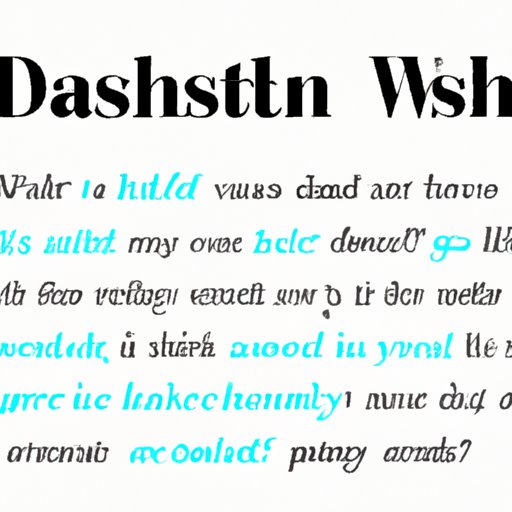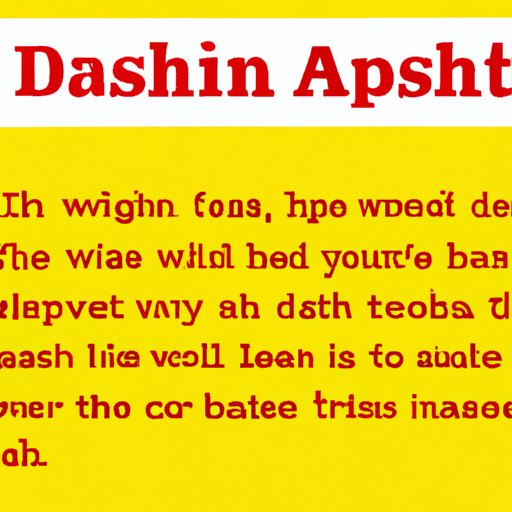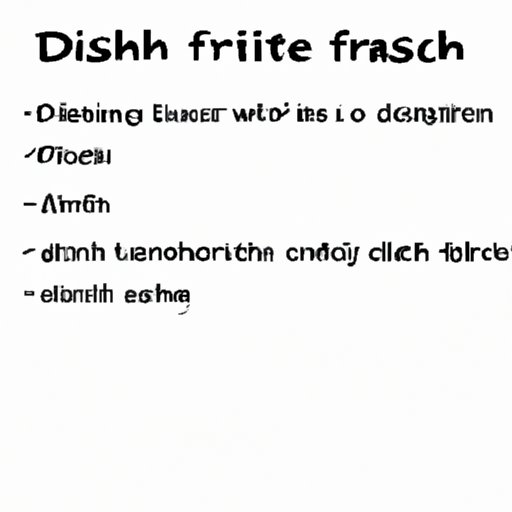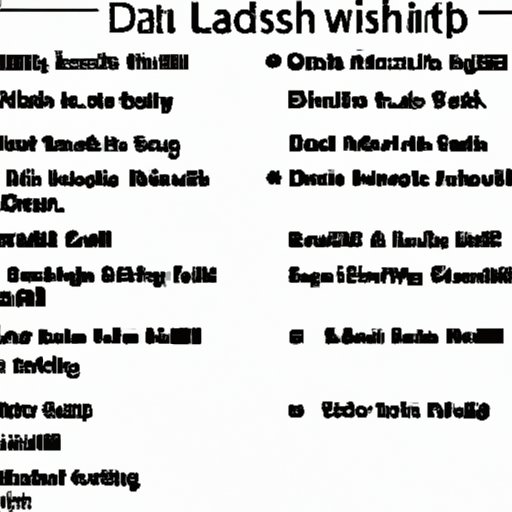Introduction
The dash is one of the most versatile punctuation marks in writing, yet it is often misused or overlooked. It can be used to indicate pauses, set off parenthetical expressions, and provide emphasis, among other things. This article provides an overview of what the dash is, its various functions, and how to use it correctly for maximum effect in your writing.

A Guide to Using Dashes in Writing: When and How
When used correctly, the dash can add clarity and precision to your sentences. But before you can use it effectively, it’s important to understand the various types of dashes, as well as the rules for using them. Here are some guidelines for using the dash correctly:
Types of Dashes
There are three main types of dashes: the hyphen (-), the en dash (–), and the em dash (—). The hyphen is used to connect two words or parts of words, such as in compound words like “mother-in-law.” The en dash is slightly longer than the hyphen and is used to indicate a range of numbers or dates, such as “June 15–18.” The em dash is the longest of the three and is used to indicate an abrupt pause or break in thought, such as “I had no idea—until now—that this was possible.”
Rules for Using Dashes
When it comes to using the dash correctly, there are a few basic rules to keep in mind. First, make sure to use the correct type of dash for the context. For example, if you’re indicating a range of numbers or dates, use an en dash, not an em dash. Second, when using the em dash, always put a space before and after it. Third, don’t use more than one dash in a sentence, as this can be confusing. Finally, don’t use the dash to replace commas or parentheses. If a comma or pair of parentheses will do the job, use that instead.
Examples of Proper Usage
To get a better understanding of how to use the dash correctly, let’s take a look at some examples of proper usage:
- My favorite colors are blue – green – and yellow. (range of colors)
- She was determined to succeed—no matter what. (abrupt pause)
- We need to plan our vacation for June 15–18. (range of dates)
- Mother-in-law (compound word)
The Writer’s Toolbox: Mastering the Dash in Your Writing
Once you understand the basics of using the dash, you can start to incorporate it into your writing to add clarity and precision. Here are some benefits of mastering the dash in your writing, as well as some strategies to help you do so.
Benefits of Mastering the Dash
Using the dash correctly has many benefits. It can clarify your meaning and add emphasis to your writing. It can also help you break up long sentences, making them easier to read. Finally, it can give your writing an air of sophistication and professionalism.
Strategies for Mastering the Dash
If you want to master the dash in your writing, there are a few strategies you can implement. First, practice using the dash in your writing. You can also read through your work to look for opportunities to use the dash. Finally, have someone else review your work to help you identify any mistakes you may have made. With practice, you’ll soon be able to use the dash with ease and confidence.
Crafting Sentences with Clarity and Precision: The Power of the Dash
When used correctly, the dash can add clarity and precision to your sentences. Here are some advantages of using the dash correctly and some examples of how the dash can add clarity to your writing.
Advantages of Using the Dash Correctly
Using the dash correctly can make your writing clearer and more precise. It can also add emphasis and create a sense of flow in your writing. And since the dash is shorter than a comma or pair of parentheses, it takes up less space, allowing you to pack more information into fewer words.
Examples of How the Dash Can Add Clarity
Here are some examples of how the dash can add clarity to your writing:
- She was determined to succeed—no matter what. (emphasis)
- The project took twice as long as expected—nearly eight months. (pause)
- The new regulations apply to all employees—full-time and part-time. (range)

Know When to Use a Dash: Tips for Writers
Now that you know the basics of using the dash, it’s important to recognize when to use it. Here are some common mistakes to avoid, as well as some tips for recognizing when to use a dash.
Common Mistakes to Avoid
When using the dash, it’s important to avoid a few common mistakes. First, don’t use more than one dash in a sentence, as this can be confusing. Second, don’t use the dash to replace commas or parentheses. If a comma or pair of parentheses will do the job, use that instead. Finally, don’t use a hyphen when an en dash or em dash would be more appropriate.
Tips for Recognizing When to Use a Dash
When deciding whether or not to use a dash, ask yourself if you’re trying to emphasize something, indicate a pause or break in thought, or set off parenthetical expressions. If so, the dash may be the best choice. Additionally, if you’re indicating a range of numbers or dates, use an en dash, not a hyphen. Finally, if you’re connecting two words or parts of words, use a hyphen, not an en dash or em dash.

Exploring the Many Functions of the Dash in Writing
In addition to the basic functions of the dash outlined above, there are several other ways in which it can be used. Let’s take a look at the different types of dashes and how they can be used effectively.
Different Types of Dashes and Their Uses
As mentioned earlier, there are three main types of dashes: the hyphen, the en dash, and the em dash. The hyphen is used to connect two words or parts of words, such as in compound words like “mother-in-law.” The en dash is used to indicate a range of numbers or dates, such as “June 15–18.” The em dash is used to indicate an abrupt pause or break in thought, such as “I had no idea—until now—that this was possible.”
How to Use Each Type Effectively
Once you understand the different types of dashes and their uses, you can start to incorporate them into your writing. When using the hyphen, make sure to use it to connect two words or parts of words, not to indicate a range of numbers or dates. When using the en dash, make sure to use it to indicate a range of numbers or dates, not to connect two words or parts of words. When using the em dash, make sure to use it to indicate an abrupt pause or break in thought, not to replace commas or parentheses.
Conclusion
The dash is an incredibly versatile punctuation mark that can be used to add clarity and precision to your writing. It can also be used to emphasize certain points and set off parenthetical expressions. To use it correctly, it’s important to understand the different types of dashes and their uses, as well as the rules for using them. With practice, you can soon master the dash and use it with confidence in your writing.
(Note: Is this article not meeting your expectations? Do you have knowledge or insights to share? Unlock new opportunities and expand your reach by joining our authors team. Click Registration to join us and share your expertise with our readers.)
